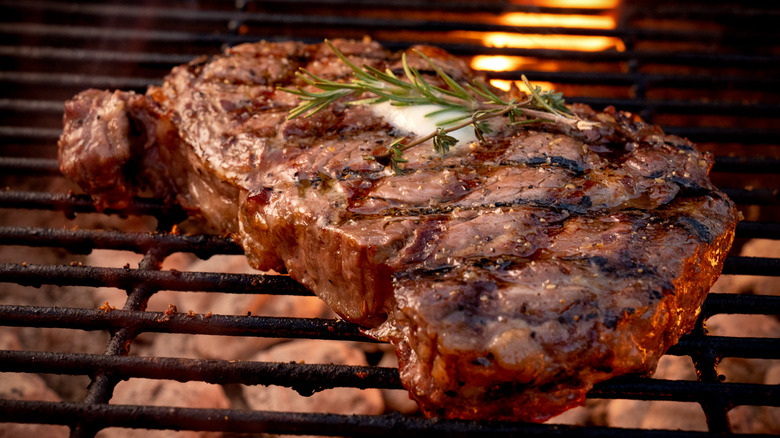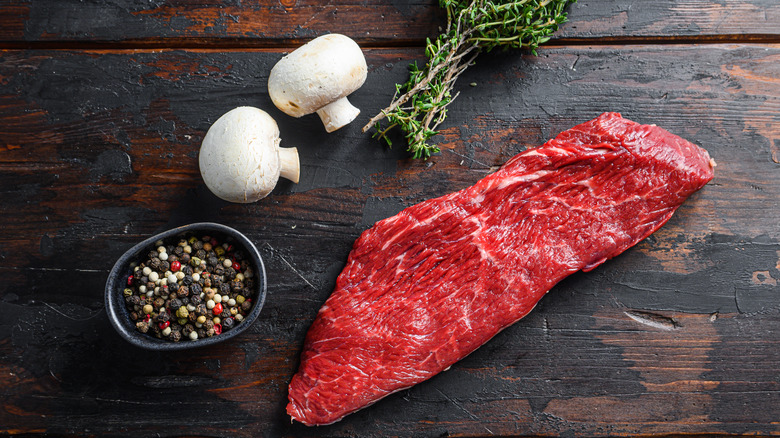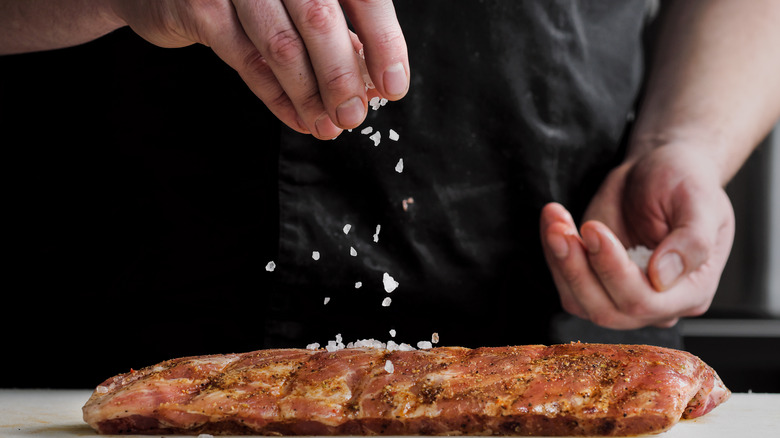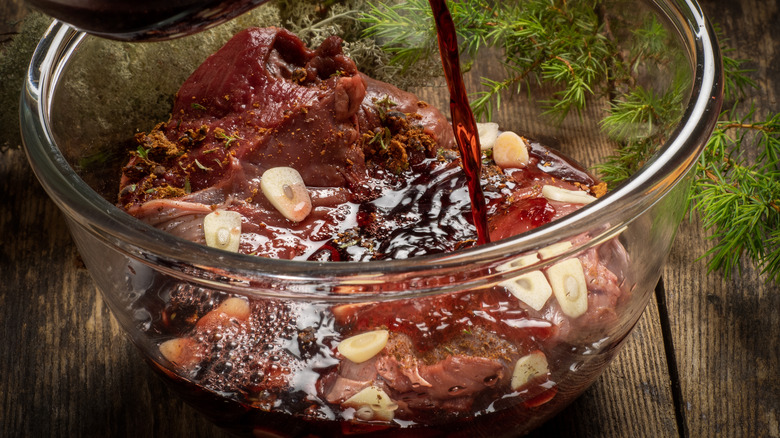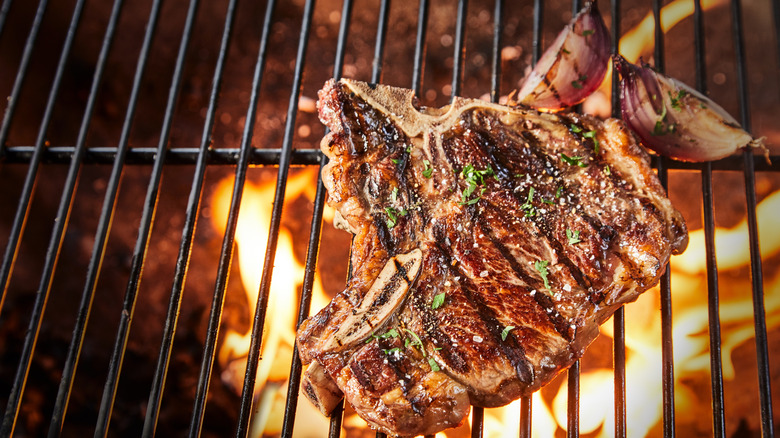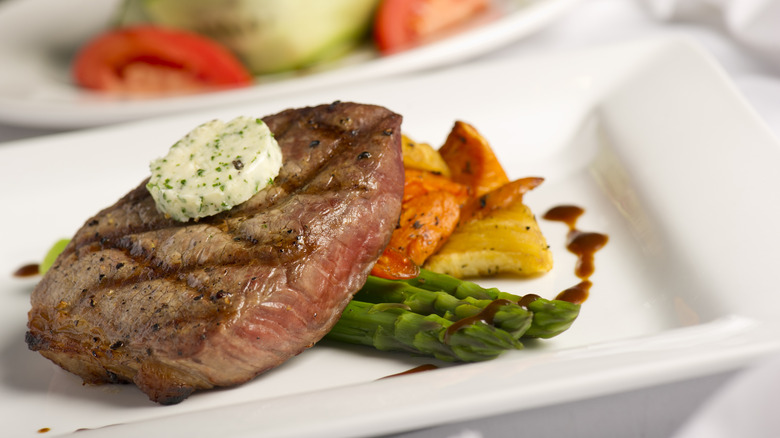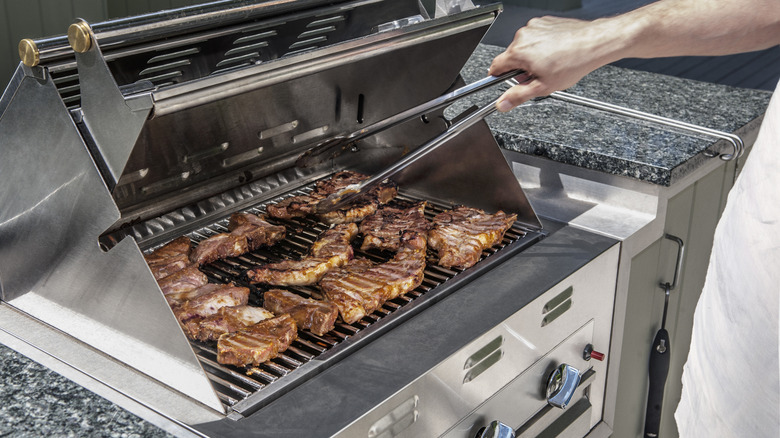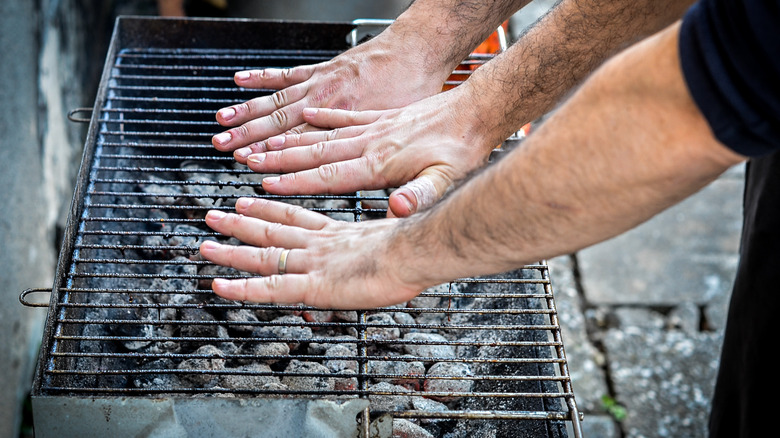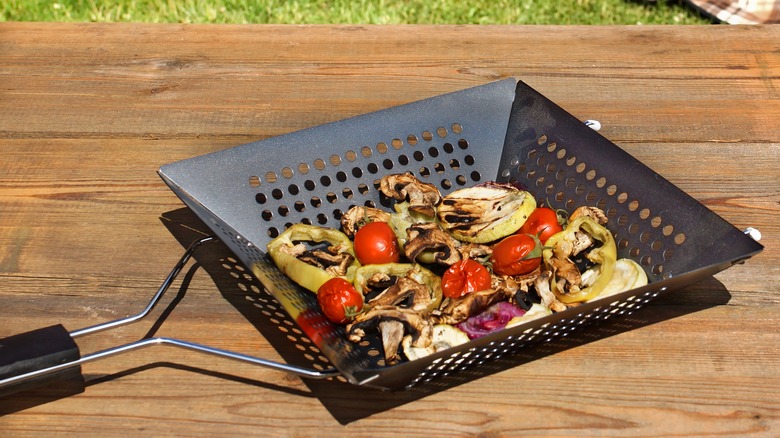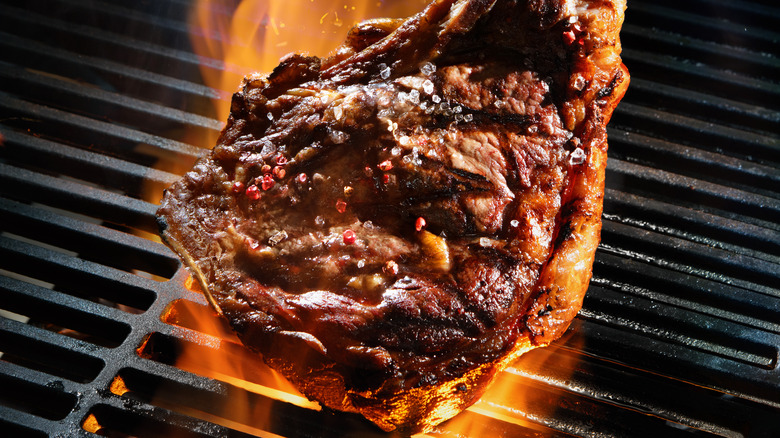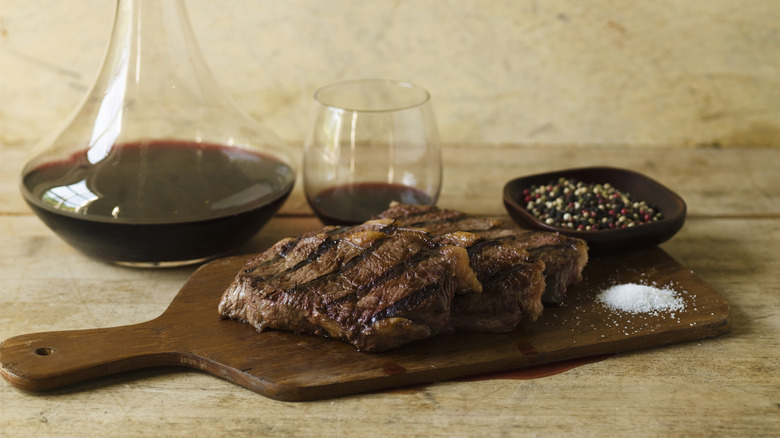12 Essential Tips For Grilling Steak, According To Hugh Acheson
You don't have to be a James Beard Award-winning cookbook author or French-trained chef with your own restaurant empire to grill a great steak, but Hugh Acheson is both, and he knows beef. Widely hailed for marrying classic southern dishes to European techniques and ingredients, the restaurateur has built out a slew of restaurants across Georgia (plus Florida's Ovide), so when he dispenses wisdom, we listen. The Georgia-based, Canadian-born chef recently shared his techniques for a perfect backyard dinner with us over a phone call, and we have brought back notes.
Here are Hugh Acheson's tips for a perfectly grilled steak and the party to enjoy it. We think you'll find that the most important part of enjoying a backyard steak isn't even the steak; it's what you do with it and whom you share it with. However, the second-most important part is that steak is properly cared for, so let's start with that.
Pick a cut of meat that can take the heat
While our article on the best cuts of meat for grilling proved even the toughest cuts of meat have a place at the forefront of a backyard barbecue, we're talking about grilling a nice chop on high heat here, so pick your slab of beef carefully: not too thin, not too lean.
"Grilling is a medium where you want some sort of gradation of fat to keep things moist," when selecting a cut, says Acheson. "It's not like roasting or a pan, where you have the ability to baste and introduce butter or fat into an area."
While he says you can marinade beforehand and baste it as you go, these will only do so much to introduce flavor and even less to keep the internal meat moist. "But that's not going to be the same," he says, so don't use those methods to bring out the steak's natural flavor so much as put a nice coat of paint on it. "So things like tri-tip and ribeye, skirt steak, and tenderloin: All those beef have enough fat in them to keep things moist."
Speaking of keeping steak moist, that brings us to our favorite means of trapping moisture in its meat matrix: the reasons why you should always salt your steak before cooking. Acheson has thoughts.
Salt scientifically for a perfectly dry-brined piece of steak.
"Salt as a general rule is .05% as a percentage of weight ratio," Acheson tells us. "A kilogram of meat is going to need 50 grams of salt." Too much salt per kilogram is going to have you reaching for a pitcher of iced tea, ruining a perfectly beautiful piece of meat.
"When you're thinking about bone-in," Acheson says. "I tend not to really think about it and season everything, including the bone, according to equal weight. If you want to adjust, you've got to gauge how much that bone weighs and adjust down from there."
With that said, Acheson says don't worry about the bone affecting the weight of the meat. It makes a minimal difference within the parameters, even for voluminous roasts. And if you go a little higher, you'll probably just end up with slightly more flavorful meat unless you've got some all-bone cut — in which case you have bigger problems with your butcher.
Take it easy on the marinades
While people think of marinades as a great way to turn steak into flavor bombs, you can't just soak a steak in one for a week and come back to the greatest piece of meat you've ever encountered. The actual timeline you're working with can be much shorter, depending on its pH.
"Any highly acidic marinade for over a period of an hour is going to begin to denature protein and make things chewy and mushy in certain ways," cautions Acheson. "So use a little less acid in your marinade." In fact, the perfect marinade ratio is three parts fat to one part acid and one part seasoning — and you don't need to make a lot just to cover the filet.
"You can add acid in later if you're looking to bring in flavor," says Acheson, "But don't do it too long." In fact, a splash of acid at the end is the very thing most meat is looking for, and one reason some cooks prefer a reverse marinade post-cook. (Obviously, you would use fresh ingredients so as not to bathe that cooked meat in its own raw juices.)
Embrace the uncertainty of grill temperature
Asked about the optimum temperature for a grill's high heat zone, Acheson plays it cool.
"It's more touch for me," he says, "and sort of a feel on how hot the coals are." Nobody ever precision-landed an exact temperature with charcoal, his preferred grilling method alongside millions of backyard chefs. But since you do have that level of control from propane and propane accessories, he's got the right advice for you, too.
"If you're using a gas grill, set it at 400 to 450. That's depending on what you're grilling. You can go down a little bit if it's something thicker. You don't want too much crust, too much char on the outside. If it's a 2"-thick ribeye, then you're going to want to go a little bit to slightly lower heat. If it's a skirt steak or flank steak or something thin, you're going to want to go to pretty immediate high heat and get the job done quickly."
When the texture is to your liking, stick a thermometer to confirm. So take it easy, eyeball the sear, don't be afraid to poke the meat, and definitely don't get hot under the collar about the perfect temperature.
Rotate the meat to cross-sear the heat
There are as many ways to sear a steak as there are cooking methods: reverse-sear, butter baste, direct fast and furious, and even the iconoclastic cold start steak sear without oil. But on the grill, unless you feel like sticking the steak directly in the flame like a maniac who wants to ruin it, you've pretty much got two options: Over a grate on the hot zone or the cooler one.
Acheson compares it to a stovetop — stick to the process unless you need to pull that chop out of a flare-up.
"It's not much movement. Let it do its thing," he says, "then give it some quarter-turns to get those nice, proper grill marks. Put it down, and say it's an inch-thick ribeye, you're going to wait two minutes, give it a quarter turn...two minutes, turn it...two minutes, take it off, and then you're going to let it rest."
Yeah, it's really that easy. And meanwhile, you're over here flipping seven steaks around an inferno like a hibachi chef on your first day.
Bet on better-tasting butter but not by basting
While Acheson's a documented fan of the butter baste in a skillet, the realities of grilling are different. You can't splash a buttery bath over a New York strip to help it achieve that delicious Maillard reaction when it runs right down into the coals and invites unwelcome flames to char your meat.
"Butter in grilling? You can definitely use it. I wouldn't use it during the process because it's just going to melt away and encourage flame and fire to be licking your meat, and that's really not what you want," he says. "I usually make compound butter or flavored butter, or just really good, quality butter, and slather that on after, during the resting process — and that's really going to keep it uber-moist, and add that lactic, nice punch to the finish."
If you've never made compound butter before, we've got the easiest compound butter technique you've ever seen. Of course, experts may want to make the butter itself out of heavy cream, but get ready for a lot of buttermilk splashback. But save it because there's plenty of use in that buttermilk elsewhere.
Know what each cooking method gets you
You've got grilling options, friend. The two most popular are charcoal and propane grills, which provide quick and direct heat. Frankly, a classic log wood grill is too much gun for this hunt if you're only trying to sear steaks on high heat quickly. Ditto, a pellet smoker, is indirect and much better applied to low and slow cooking. There's even a solar cooker — though we don't recommend you sear a steak with it. The tech just isn't there yet, though other solar grills do absorb the sun's energy and then cook electrically with it. But we digress; which of the two big ones does Acheson pick?
"My preferred method of grilling is probably charcoal overall," says the chef. "They're all going to work well. There's nothing wrong with gas; it's easy, it's immediate, it's fast. It's just if you want nice charred, smoked meat, then you want to go charcoal."
We're inclined to agree. That smoky element is so essential to summer cooking. It's the one aspect you can bring to a grill that can't be done inside without a visit from the fire department. You're already outside to avoid heating up the entire house making dinner, so you might as well make the meat taste incredible.
Eyeball doneness, but only so you know when to measure
With so much variance in cuts of meat and coals, hard and fast rules can only take you so far. Acheson says most governmental guidelines are based on absolute safety certitude rather than a minimum effective dose of heat.
"Really, it just depends on the meat, on the structure of it. Even within a steak, it's done on touch more than anything. The age-old rules are very big blanket statements. If you just practice and grill often, you'll get it down to a science."
It's more important to get a sense of when the beef is ready than it is to watch the clock. That way, you can anticipate its completion, no matter the shape or size. Once you have this down, you can bring in a meat thermometer without sticking your steak too many times.
"Basically, if you're going to 130, you're going to want to pull at 125. Proteins coming off of heat are still going to rise in temperature as they rest. So if I'm going to 122, I'm usually pulling at 118 and then letting rest. So it's better to go slightly under than slightly over...unless you're talking about chicken, then slightly over. The resting is the most important thing. I use a really good Thermopen thermometer. Invest in a good thermometer if you're going to be grilling."
Adjust your technique to the method
Acheson says that your grilling is similar to indoor cooking, but there are a few extra considerations, such as the smoke factor and flare-ups. "For outdoor grilling, use a spray bottle of water to quell any flare-ups that you have."
Similarly, he says to get a pair of long tongs, so you can manipulate the meat without cooking your hands in the process. Beyond dodging pitfalls, he says to use the grill's unique features for what you can't do in the kitchen. "Perforated baskets are really good for vegetables. You can always direct-grill something on the coals [themselves]. Things like eggplant are great for that," he says.
Since their skin is often peeled off anyway, consider using the on-the-coals method for nightshades or squashes with tough hides that will either become edible or peel away, leaving only a soft interior. These veggies are delicious with your steak or bring a smoky note to your next baba ganoush, caponata, or salsa. Just make sure to pull them off before they overcook. While their water content makes them unlikely to scorch to any sort of detrimental degree, they may steam internally to the point where they pull apart. Ashes in your dinner is nobody's idea of a good meal.
Be patient with your charcoal
When asked what the most common mistake is among amateur grillers, Acheson leaps to a ready answer that he has witnessed countless times. "Charcoal needs to cook down to an ashen color. If it's still black, it's probably — if you're using instant-light charcoals — it's probably flavored with gassy additives to light it faster. So make sure that's all cooked down, and that'll produce a very ready-steady heat overall and be less prone to flare-ups."
If that gassy flavor is still a problem, switch to a natural lump charcoal. You can dispense with lighter fluid entirely if you get a chimney lighter. Combined with some alternative kindling in our 10 tips you need when cooking with charcoal, and you should be all set to get the fire roaring. Simply wait patiently until it dies down to beautiful orange and grey embers before your food hits the grate.
Rest the meat sensibly and expediently
"How long do you let it rest?" muses Acheson. "That completely depends. A skirt steak or a piece of salmon needs to rest just as much as a turkey does at Thanksgiving but for less time. An inch-and-a-half steak — ribeye or New York strip — is going to be probably ten minutes. A skirt steak is going to want five minutes."
Okay, that all tracks. But his real advice is in how you let it rest. Most people let it sit on a cutting board or a platter, but that insulates the bottom of the food. Not Acheson. "I tend to rest on a cooling rack over a sheet pan. There's just a lot of airflow all around it. Do not cover it when resting because that will trap in the steam, and it can change the cook at an accelerated rate."
And don't worry about the meat growing cold. Acheson has a way to fix that, if you even need to, without overcooking it. "The dilemma is, what if it cools down too much? Well, you can go inside, turn the broiler on, pop it in there just to get some good surface heat on it. It's probably only cooled down on the outside and not on the inside."
The best side serving to a great grilled steak isn't edible
If you want recommendations for good sides, Acheson has you covered. "I love long-cooked little potatoes wrapped in foil with leeks and butter. You can do that as a little foil pack directly packed in the coals. I love grilled asparagus, I love grilled peppers — I love grilling peppers on the 'cue, then tossing them with anchovies and basil and tomatoes, onions, and olive oil with a little bit of lemon. Things like that are great."
Though Acheson's favorite accompaniments to a perfectly seared steak on the grill aren't even necessarily edible. Along with "a cooler of beer or rosé, friends and family," you're ready to relax.
"You kind of want to think like the South Africans do about grilling: The creation of a whole outdoor kitchen, almost," he says. "And that is the convivial space where everyone can gather and enjoy themselves. So that's what you're thinking of when you think of outdoor grilling. It's not just the cooking element outside. It should be more like an enjoyable way of living the day."
And that's a mighty good ethos to cook from. If you can't afford to hire him to grill for you, at least you've got a blueprint based on his knowledge.
